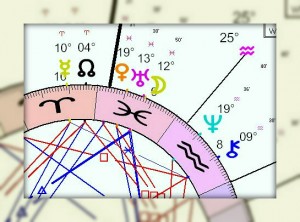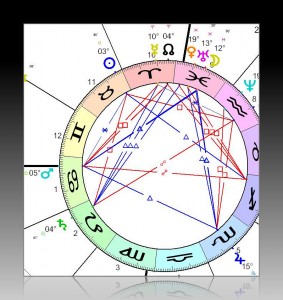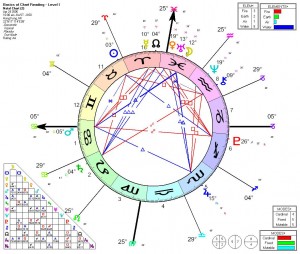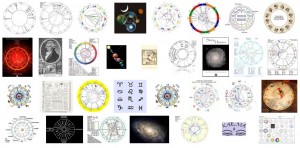We talked about aspects in the past few posts. One more thing on that.
You may wonder how do we know whether 2 (or more) planets are “in aspect” (or “aspecting each other”). What is the criteria to determine that they can communicate with each other? Is it because of their nature? Is it for some other reasons, based on time, or space?
The truth is, this is an issue that has divided astrologers since… forever! So, I’ll tell you the theory, and you will have to experiment for yourself (after you have taken the course! 🙂 clever hint!) to see what works for you.
OK, so here it is: you probably have not noticed yet on the charts I showed you on the previous posts, but next to the planets, you can see a small figure next to the glyph. It is the ‘degree’. In the example below, you can see a yellow colour crescent (it is… the Moon. Dah!) and next to it ’12°’. It means that the Moon is at 12 degrees of Pisces (the sign next to the figure 12).
So once you know the degree of a planet, you can look for planets that are on the same degree (either of the same or different signs) to establish the aspects. For example, a planet that is at 12 Pisces and a planet that is at 12 Gemini will be in ‘exact aspect’.
It is very rare that 2 planets will be on EXACTLY the same degree, so you will need to allow for some variation on both sides of the degree when you consider that 2 planets aspect each other. The variation you allow is called an “orb”.
In the example above, you see that Moon at 12 Pisces and Mars at 5 Cancer (the turquoise colour glyph on the left hand side) at considered in aspect (there is a blue line connecting them) even though they are 7 degrees apart. The Sun (the dark blue circle with a dot in the middle) is at 3 Taurus and it is also in aspect to Mars, they are only 2 degrees apart.
The closer the orb, the more potent the aspect. So 2 planets which are on the same degree (although possibly in different signs) will have a strong connection.
You may be wondering: Up to which orb are 2 planets still in aspect? Whats is the rule of thumb for me to know that, ye, those 2 planets ARE in fact talking to each other and influencing each other?
Ah! Tough question. This is where astrologers have different views. Some people will consider that an acceptable orb is 5 degrees on both sides (so in the case of 12 Pisces, they will consider any degree between 7 and 17, i.e. 12-5 and 12+5 are valid aspects). Some will allow for a larger orb (usually up to 10 degrees on both sides), but some will have a stricter view. It depends.
Valid orbs also differ depending on what branch of astrology you practice, for example Mundane astrology, the astrology used to determine world affairs and events, or Horary astrology, which casts charts to answer questions, tend to use very narrow orbs. Progressed charts use only exact aspects. But this is out of our subject.
Want to know more and understand what’s behind all this? Sign up on the Astro Coach Academy Members List to get more in depth insights into how to interpret a chart and get members-only benefits when the eCourse comes online.



